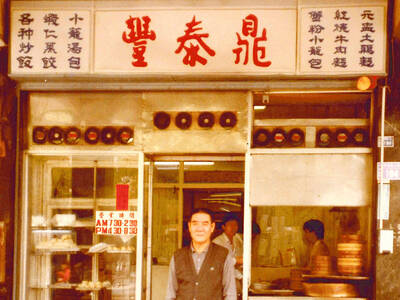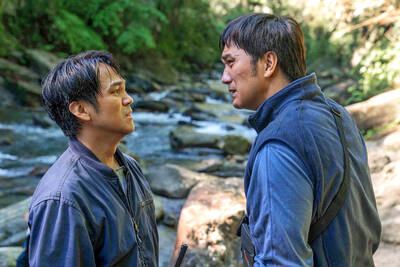Edward Greve orders all his meals in Taiwanese. If the server doesn’t understand, he’ll switch to English and then Mandarin as a last resort. But, he says, when a Taiwanese friend does the same, especially in Taipei, he’s often criticized for being vulgar or low-class.
“Taiwanese should be treated for what it is, but it really is discriminated against,” Greve, a US expat who goes by A-iong (阿勇), says. “As a foreigner, I don’t face that directly, but when I’m with people who speak Taiwanese, I see it.”
A-iong is one of a growing number of social media content creators who are promoting Taiwan’s struggling non-Mandarin languages that were suppressed for decades by the government. While attitudes and policy are changing, stereotypes or the lack of resources make preserving these languages a challenge.

Photo courtesy of Umav Ispalakan
YouTuber Tsao Chen-ying (曹辰瑩), has only been learning the little-known Matsu dialect of the Eastern Min (閩東) language for less than a year. Unaccustomed to speaking the language with young people, Tsao often has to remind the older people on the remote offshore islands not to revert to Mandarin in her videos, which also introduce Matsu culture.
Umav Ispalakan’s Facebook page featuring Bunun language illustrations has become a conduit to present deeper issues such as cultural identity, indigenous rights and persistent stereotypes.
“When you start learning your mother tongue, you will inevitably run into these issues,” she says. “Why are so many young people unable to speak them? That has a lot to do with our history … If we don’t look at it from a transitional justice or a decolonization perspective, it’s really hard to even scratch the surface of our people’s circumstances and their needs.”

Photo courtesy of Umav Ispalakan
Neither three proclaim to be language teachers, but they hope that they can bring positive attention to these languages and serve as an alternative resource.
“Independent media and other non-official sources are also needed,” Umav says. “Sometimes official material differs from how the local community speaks, and learners should cross-reference between the two. I hope that there will be even more resources for the next generation.”
SPEAK THE LANGUAGE

Photo courtesy of Aiong Taigi
Like most people her age from the outlying island of Matsu, Tsao’s parents barely spoke to her in the Matsu dialect. She drifted even further from it after living in Shanghai for six years, but after returning to Taiwan last summer due to the COVID-19 pandemic, she felt driven to learn it.
“At first, I wanted to make a podcast to record my progress,” she says. “But I couldn’t speak it well yet, and this is a language that few people know, so I wanted to add subtitles. Only later did I become a YouTuber.”
Tsao started by writing a script for her videos and asking her mother to correct it and read it back to her. In half a year, she was able to internalize the language and stop translating from Mandarin. She eventually moved back to Matsu, where she tries to speak it to everyone she sees.

Photo courtesy of Umav Ispalakan
“Their first reaction was to reply in Mandarin, but I kept telling them, speak the language, speak the language,” she says.
At first, her family found her new-found interest annoying as she bugged them constantly, and some elders could not see the point of her exercise.
“Before, it was forbidden to speak it, and people who went to other places to study or work were discriminated against because of their accent,” Tsao says.

Photo courtesy of Tsao Chen-ying
But soon, people began to recognize her efforts.
“I wanted to use it to speak to the older generation,” she says. “If you use a language they’re more familiar with, you’ll get a deeper understanding and they’ll be more willing to share as well.”
Tsao feels that she’s inspired her friends too, and she’s noticed them speaking more in the Matsu dialect these days. And she’s reached others who know very little about Matsu or that it has a unique language.
“The old way of learning language is not suitable for today’s age,” Tsao says. “We are used to absorbing information in more visual and entertaining ways. Only if you enjoy the process can you stay motivated.”
For more information, visit: bit.ly/3DB620E.
CHALLENGING MANDARIN
A-iong had no idea that Taiwanese existed when he arrived in Taiwan from the US about 13 years ago. He started tackling the language when he moved to Kaohsiung around 2011, but says he’s only been seriously studying it for the past five years.
“What drew it to me initially was that it was what people spoke there,” he says. “There’s nothing fancy about it.”
What pulled him even in more was how few resources he could find, which challenged him to try even harder.
“Once I started understanding enough of it to sing songs, listen to speeches, I found them more interesting in Taiwanese than Mandarin,” he says. “I thought, ‘This is really cool, this is Taiwanese culture.’”
A-iong hopes to challenge the hegemony Mandarin has over Taiwan, which dominates after being forced upon the populace after World War II.
“What’s the role of Mandarin? If you want an international language that the whole world uses, there’s English, which people demonstrably want. What else do they want? They want to be Taiwanese, then there should be an English-Taiwanese thing going on.”
A-iong adds that any language commonly spoken on Taiwan would work too, but Taiwanese has the highest chance of breaking through.
“You’re not going to convince the population here to do everything in Pangcah or Paiwan — that would be great, but it’s not going to happen. With Taiwanese, there’s enough of a user base that it can happen. My hope is that Taiwanese can be the first one to break through the Mandarin wall, and once that’s down the people can be like, hey, we can do ours too.”
But it won’t happen as long as his Taiwanese friends keep getting glances or sneers for speaking it.
“I recognize that being white, people will take a second look whereas if it were a Taiwanese person they wouldn’t,” he says. “Maybe I can be a voice for some people who wouldn’t have gotten to speak up.”
A big part of A-iong’s videos focus on writing Hoklo, and he’s published a translation of The Little Prince with Chinese characters and romanized Taiwanese. This is important since much communication is done through text messaging today.
“Some people say it doesn’t matter, we’ll just talk, but it’s really hard to just pick up a language after a certain age. You need text. If you don’t have a commonplace written language, it’s going to die. You see a huge amount of information in writing every day now, and if everytime you see it you have to switch back to Mandarin or English, you’re not training your Taiwanese mind.”
Finally, A-iong also hopes the Taiwanese-speaking community cuts learners some slack: “One problem is that they have a very narrow band of acceptability; you’ve got to be right on the mark or people will complain and make fun of you.”
For more information, visit: bit.ly/3y3Ncy8.
IDENTITY STRUGGLES
As a half Bunun, half Atayal Aborigine, language is closely tied to Umav’s identity and cultural self-esteem. She recalls when she was 15, her school made her to use her now-defunct Chinese name for two years because her eight-character long Bunun name was too long.
“I actually felt embarrassed that I was causing them trouble, and my student ID showed a different name than my personal ID for two years,” she says. “Thinking back, that was ridiculous. After I learned to speak up for myself, all these experiences became my source of inspiration.”
Although Umav’s parents took pride in their identity, they spoke different languages and communicated in Mandarin at home. The family also moved around a lot, and Umav had little opportunity to practice in a community.
“My father is a Bunun language teacher, but he never forced us to speak it,” she says. “He wanted us to truly identify with it and desire to learn it on our own initiative.”
Umav started her illustration page in 2016 adding in Bunun words and phrases that she learned from her father. Today, the page seems to be just as much about identity, history and depicting the challenges and stereotypes indigenous people face, as she hopes to provide an alternative portrayal of her people than the mainstream media.
“Sometimes my posts are about language, sometimes current events, and sometimes I call offenders out on it. There are comics about the absurd things we encounter regularly as Aborigines.”
Interestingly, her page also attracted overseas Han Taiwanese, who tell her that they finally understand how she feels after living abroad as minorities.
“But this is every day for us,” she says. “I’m not trying to gain sympathy, but mainstream society just won’t learn. You all should reflect and try to understand our situation and learn what is respect and nonviolent communication. There is no way I can just look at this rationally. I invest a great deal of emotion in running this page.”
Some of her friends warn her about speaking too directly, but Umav doesn’t feel like pretending anymore.
“There is a reason we don’t speak our mother tongue, and that is because of the past unjust policies of the government. We have to continue this conversation. My drawings may be pretty and cute, but once you click in, you’ll see that what I want to say is quite serious.”
Umav acknowledges that it is hard to find an environment to speak Bunun these days.
“You have to be deliberate and diligent about it if you want to learn. But I’m not saying that one needs to speak their mother language to qualify as indigenous. There are many ways to embrace and preserve our culture.”
Umav hopes that she can inspire younger Aborigines who are going through similar identity struggles.
“I hope that they don’t feel so lonely, and my page can keep them company and also teach them how to educate others.
“Asa kata tu muskun mintamasaz,” she says. Let’s work hard together.
For more information, visit: www.facebook.com/bununeveryday.

March 24 to March 30 When Yang Bing-yi (楊秉彝) needed a name for his new cooking oil shop in 1958, he first thought of honoring his previous employer, Heng Tai Fung (恆泰豐). The owner, Wang Yi-fu (王伊夫), had taken care of him over the previous 10 years, shortly after the native of Shanxi Province arrived in Taiwan in 1948 as a penniless 21 year old. His oil supplier was called Din Mei (鼎美), so he simply combined the names. Over the next decade, Yang and his wife Lai Pen-mei (賴盆妹) built up a booming business delivering oil to shops and

Indigenous Truku doctor Yuci (Bokeh Kosang), who resents his father for forcing him to learn their traditional way of life, clashes head to head in this film with his younger brother Siring (Umin Boya), who just wants to live off the land like his ancestors did. Hunter Brothers (獵人兄弟) opens with Yuci as the man of the hour as the village celebrates him getting into medical school, but then his father (Nolay Piho) wakes the brothers up in the middle of the night to go hunting. Siring is eager, but Yuci isn’t. Their mother (Ibix Buyang) begs her husband to let

The Taipei Times last week reported that the Control Yuan said it had been “left with no choice” but to ask the Constitutional Court to rule on the constitutionality of the central government budget, which left it without a budget. Lost in the outrage over the cuts to defense and to the Constitutional Court were the cuts to the Control Yuan, whose operating budget was slashed by 96 percent. It is unable even to pay its utility bills, and in the press conference it convened on the issue, said that its department directors were paying out of pocket for gasoline

For the past century, Changhua has existed in Taichung’s shadow. These days, Changhua City has a population of 223,000, compared to well over two million for the urban core of Taichung. For most of the 1684-1895 period, when Taiwan belonged to the Qing Empire, the position was reversed. Changhua County covered much of what’s now Taichung and even part of modern-day Miaoli County. This prominence is why the county seat has one of Taiwan’s most impressive Confucius temples (founded in 1726) and appeals strongly to history enthusiasts. This article looks at a trio of shrines in Changhua City that few sightseers visit.